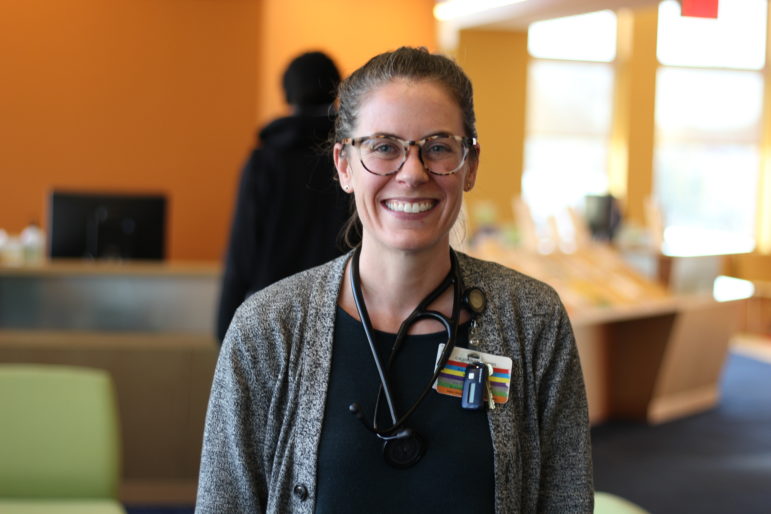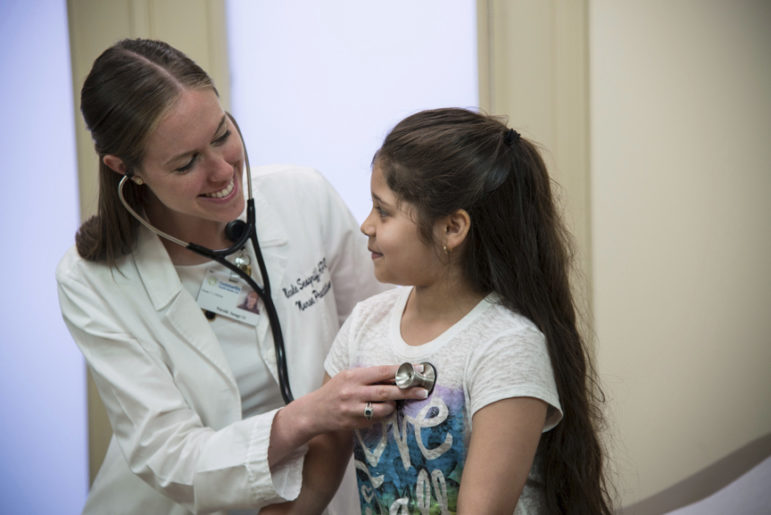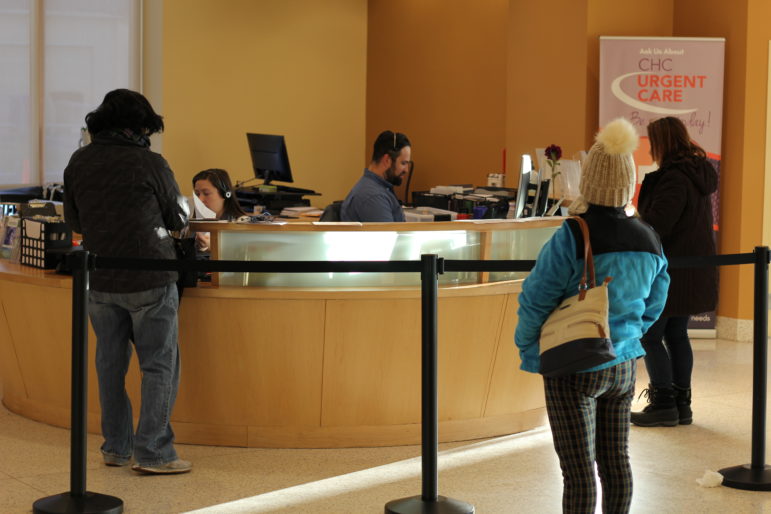By Steve Hamm
Alison McGrory-Watson, a private cook who lives in Deep River, had serious medical problems, including Hepatitis C and post-traumatic stress disorder (PTSD), when she was assigned Nichole Mitchell as her primary care provider at Community Health Center Inc. (CHC) in Middletown.
McCrory-Watson was uninsured, and Mitchell went to great lengths to get financial assistance for two new drugs aimed at addressing her medical problems. As a result, McGrory-Watson is now Hep C-free, and she hopes a drug she’s taking for PTSD will quell the lingering effects of being gang-raped as a teenager and witnessing a brutal stabbing as an adult.
There’s something about Mitchell that might surprise you. She’s not a doctor; she’s a nurse. A nurse practitioner (NP), to be precise. But McGrory-Watson insists that the care Mitchell provides is every bit as good as she would get from a physician. “In my opinion, people shouldn’t worry about being treated by a nurse practitioner; they should be glad,” she says. “Nichole brings the holistic approach of truly knowing me and not just seeing a list of symptoms on a page.”

Steve Hamm Photo.
Nichole Mitchell, a nurse practitioner, provides primary care at the Community Health Center, Inc., in Middletown.
There are likely to be many more people like Nichole Mitchell in our future. The number of medical students seeking careers as primary care providers is lagging while nurse practitioners overwhelmingly choose careers in primary care. Meanwhile, demand for primary care providers is growing due to the opioid crisis, the aging population and an increase in chronic illnesses.
Already, the federal government’s Health Resources and Services Administration estimates that 13,800 additional primary care physicians are needed to meet current demand. The shortage could grow to 50,000 by 2030, according to a study prepared for the Association of American Medical Colleges (AAMC). And, if the promise of universal health care becomes a reality, it could top 95,000.
In Connecticut, 3,786 of the state’s 12,341 active physicians are in primary care, according to the AAMC. To maintain today’s status quo, Connecticut will have to add more than 400 primary care physicians by 2030, according to analysis by The Robert Graham Center.
Advocates for physician education propose policy changes that could help persuade more doctors to seek careers in primary care, including increases in loan forgiveness. At the same time, some medical schools, including Quinnipiac University’s Frank H. Netter School of Medicine, have programs that focus on primary care.
Still, nurse practitioners are already a major component of the primary care workforce, and health care leaders are counting on them to increasingly take responsibility for comprehensive primary care. A study published last year in the New England Journal of Medicine estimates that more than half of the primary care providers nationwide in 2030 will be NPs or physician assistants (PAs). The number of NPs is expected to grow 47 percent by 2025. “It has become clear that you can’t improve health care in the United States unless you unleash the power of nursing,” says Ann Kurth, dean of Yale School of Nursing.
Nurse practitioners typically complete a baccalaureate degree in nursing and a two-year master’s degree compared to seven years of post-baccalaureate training for physicians.

Michael Melford Photo/CHC
NP Nicole Seagriff exams a patient.
Connecticut health care leaders are counting on improved primary care to head off more serious medical problems and more costly treatments—pushing a team approach where physicians, nurse practitioners, physician assistants, behavioral therapists and others work collaboratively. “We want to meet all the patients’ needs at the door, and nurse practitioners play an important role,” says Vicki Veltri, executive director of the Connecticut Office of Health Strategy.
In Connecticut, seasoned NPs are permitted to evaluate patients, diagnose illnesses and prescribe medications—all without physician supervision. The ranks of advanced practice registered nurses grew from 1,772 in 1998 to 5,382 last year, according to the Department of Public Health. Most of them are nurse practitioners.
For her part, CHC’s Mitchell objects to nurse practitioners being viewed as fill-ins for doctors. “Family nurse practitioners didn’t go to school to be physician extenders but rather independent clinicians. We stand on our own two feet and do consistently great work,” she says.
In fact, studies show that the quality of care provided by NPs typically matches or exceeds that of physicians—and costs are lower because of the salary differences. An article published in 2017 in the journal Medical Care concluded that NPs matched the quality of care and outperformed doctors when it came to providing health counseling.
At CHC, which serves 145,000 patients across Connecticut, roughly 50 percent of primary care providers in its health centers are nurse practitioners. They provide pediatric, adult, family and women’s health services, plus behavioral health services. In Fairfield County, primary care clinics are located in Norwalk, Stamford and Danbury. “NPs have always been equal partners here, both in clinical practice and in leadership,” says Margaret Flinter, senior vice president and clinical director, who began as CHC’s first NP in 1980.
Many primary care physicians in the state welcome the expanding role of nurse practitioners, though some express concerns. The Charlotte-Hungerford Multispecialty Group in Torrington employs a number of nurse practitioners, yet Stacy Taylor, MD, a primary care physician there, says, “You can’t say that all NPs can work without supervision. We really focus on teamwork. We’re all available to help each other out.”
Connecticut permits licensed NPs who have been practicing in the state for at least three years under a physician’s supervision to work independently and to the full extent of their training. This is called full practice authority. Twenty-one other states have similar regulations. The others are more restrictive.
CHC has been a national leader in providing advanced training for nurse practitioners. Flinter established the nation’s first postgraduate residency program in 2007, and now there are 60-some NP residency programs around the country. “We are asking NPs to be at the center of primary care, and we want to give them the opportunity for intensive postgraduate training that is focused on clinical complexity and on a high-performance model of care,” says Flinter.

Steve Hamm Photo.
Patients wait to check-in at the Community Health Center, Inc., Middletown.
The organization is also a pioneer in using technology to help NPs—along with physicians and PAs—provide the best care for their patients. One program, eConsult, enables primary care providers to interact with specialists via a digital platform. They receive answers to their questions about patients in 48 to 72 hours—rather than requiring patients to wait months for appointments with specialists. They also get expert advice on the best treatment options. “It’s a tremendous learning opportunity for us. We connect with experts and learn from them,” says Nicole Seagriff, a nurse practitioner at CHC’s Norwalk office.
CHC’s program is now running for 12 specialties, and it’s cutting the need for face-to-face specialist consults by 30 percent. It saves the Medicaid system $84 per CHC member per month.
While some states balk at granting full practice authority, the dam holding back NPs seems to be bursting. The Veterans Administration Health Service and other federal agencies have given NPs and nurse midwives independence in all 50 states. They and others, including retail clinics, such as CVS, are hiring them aggressively.
“We want to see changes in the way health care is provided in this country,” says Monte Wagner, a nurse practitioner who works at the VA in West Haven and is an officer of the Connecticut Advance Practice Registered Nurse Society. “Too many states don’t allow full practice authority. That’s the biggest change we need to see.”
Support Our Work
The Conn. Health I-Team is dedicated to producing original, responsible, in-depth journalism on key issues of health and safety that affect our readers, and helping them make informed health care choices. As a nonprofit, we rely on donations to help fund our work.Donate Now

